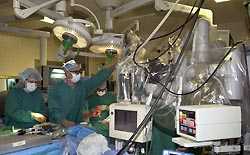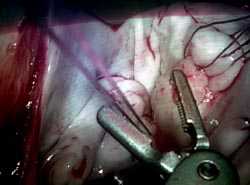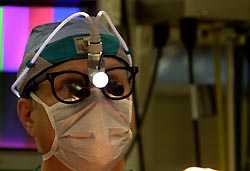ECU surgeons to lead FDA multi-center robotic surgery trial
Cardiac surgeons at University Health Systems of Eastern Carolina will lead a national multi-center clinical trial using the da Vinci Surgical System for mitral valve repair. Dr. W. Randolph Chitwood Jr., chairman of the Department of Surgery at the Brody School of Medicine at East Carolina University, will serve as principal investigator of the six-hospital study.
The U.S. Food and Drug Administration granted approval today for the use of da Vinci for mitral valve repairs at The Heart Center within Pitt County Memorial Hospital along with five other major heart centers across the nation. Chitwood and the cardiac surgical team at University Health Systems conducted the first FDA-approved trial in North America for mitral valve repair using da Vinci. The trial, involving 10 patients, began May 3. On Nov. 6, Chitwood received FDA approval for a second clinical trial for 10 additional patients. This week, he will complete cases 14 and 15 using the minimally invasive, robotic-assisted technique.

Cardiothoracic surgeons at University Health Systems of Easten Carolina in Greenville prepare the da Vinci surgical robot for a mitral valve procedure. Photo by Cliff Hollis.
The multi-center FDA trial will involve 60 to 90 patients, with each center enrolling with 10 to 15 patients. Before participating in the trial, surgeons at the five other medical centers must receive training using da Vinci for this procedure through the Robotic Surgery Training Center at ECU. To date, 10 teams of surgeons from other medical centers have been trained to use da Vinci in general and cardiac surgery.
The purpose of the multi-center trial is to gather data from a broader spectrum of patients using different surgical teams in order to add statistical validity to clinical results and patient outcomes.
“The expansion of the clinical trial from our work at University Health Systems demonstrates the promise this new technology holds for expanding the use of robotics in cardiac surgery,” Chitwood said. “The use of this advanced surgical technique is producing positive outcomes for our patients.”
Cardiothoracic surgeons use mitral valve repair to treat a narrowing or leakage of the mitral valve. The mitral valve is the inflow valve for the left side of the heart that allows blood to flow from the left atrium into the left ventricle. When the valve leaks, blood backs up into the lungs and causes the ventricle to pump more blood. Symptoms include shortness of breath and fatigue. Traditional open-heart surgery requires surgeons to make an 8- to 10-inch incision by sawing through the sternum to open the rib cage to gain access to the heart.

The da Vinci’s EndoWrist instrument translates the surgeon’s natural hand and wrist movements. The instrument is approximately the size of a pencil. Photo by Cliff Hollis.
With the da Vinci Surgical System, Chitwood and his colleagues make three dime-sized incisions before inserting three robotic arms into the chest. One arm holds a tiny camera that projects three-dimensional images onto a monitor in front of the surgeon; the other two arms hold the pencil-sized instruments, which have tiny computerized mechanical “wrists” designed to transmit the dexterity of the surgeon’s forearm and wrist into the chest at the operative site.

Dr. Randolph Chitwood, lead investigator, has pioneered the use of robotic-assisted surgery for mitral valve repair. Photo by Cliff Hollis.
Seated at a computer console located approximately 6 feet away from the operating table, the surgeon views a magnified, three-dimensional image and manipulates the surgical instruments using two joystick-like devices.
“The robotic technology is so precise, and it eliminates all tremor that occurs with the human hand,” Chitwood said. “Our initial experience with the da Vinci Surgical System has clearly demonstrated that this complicated, otherwise invasive procedure can be safely conducted through several small incisions with exceptionally good patient outcomes. The patients in our feasibility study experienced much less pain and trauma, had better cosmetic results and spent less time in the intensive care unit and hospital compared to conventional mitral valve surgery where the patient’s breast bone is divided in half.”